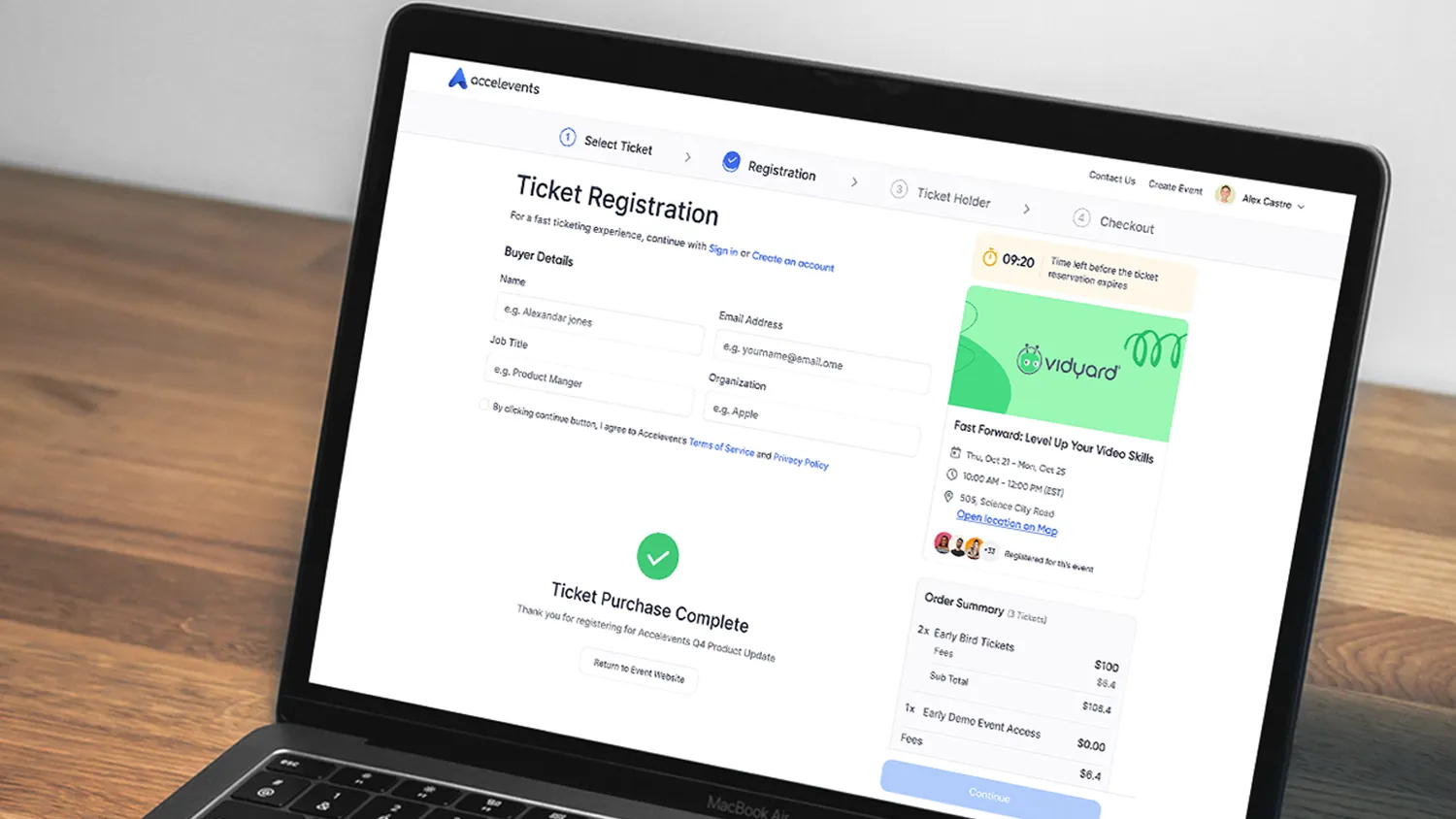A practical blueprint for planning, optimizing, and scaling event ticketing and registration, from first click through on-site check-in. This guide is for marketing, operations, and revenue teams that want higher conversion, cleaner data, and a smoother attendee experience. When you want to compare capabilities or see a live workflow, review event registration software.

What counts as event registration and ticketing?
Registration spans the journey from landing page to payment, confirmation, and check-in. It includes offer strategy, form UX, payments and taxes, policies, pre-event communications, and the data that powers analytics and CRM. To evaluate your setup, keep these dimensions in view:
- Offer architecture, ticket types, capacities, bundles, discounts, and approvals.
- Form UX and data hygiene, required fields, conditional logic, validation, accessibility, and mobile.
- Checkout and payments, gateways, currencies, taxes, refunds, and fraud controls.
- Performance and reliability, speed, mobile responsiveness, and availability during spikes.
- Instrumentation, UTMs, GA4 and pixels, and funnel reporting from views to purchase.
- Governance, policies for transfers and substitutions, consent and compliance, and support workflows.

How registration data should flow, at a glance
Your registration experience collects visitor and order data, then pushes confirmations, calendar holds, and reminders. Downstream, analytics and pixels measure funnel conversion and paid performance, CRM and MAP enrich profiles and campaigns, and on-site systems use the final roster for check-in and badge printing.
- Source events include product page views, form starts, errors, successful purchases, refunds, and substitutions.
- Destinations include GA4 and pixels for attribution, CRM and MAP for lifecycle actions, and on-site for check-in lists and badges.
- Latency should be near-real-time for confirmations and roster updates, and daily for settlements and finance.

Outcome-first playbooks
Each playbook explains why it matters, what good looks like, and how to verify it in a demo.
Playbook 1: Design high-converting forms
Why it matters
Form friction is the most common source of drop-off. Clean inputs and clear steps improve conversion and downstream reporting accuracy.
What good looks like
- Short forms with only essentials up front and progressive steps for the rest.
- Conditional logic that hides irrelevant questions and enforces rules by attendee type.
- Live validation, clear inline messages, and accessible labels.
- Mobile-friendly layout and fast page loads on cellular connections.
Verify in a demo
Open the form on mobile and desktop, trigger validation errors, and complete a test order while GTM is in Preview. Confirm GA4 receives view_item, add_to_cart, and purchase with value and items.
Tighten inputs and reduce drop-off using how to add conditional logic to your event registration form, and align tooling choices with top event management software features to help you stay competitive.

Playbook 2: Build a smart offer and pricing strategy
Why it matters
Clear offers, capacity controls, and discounts that match buyer intent boost revenue and reduce manual exceptions.
What good looks like
- Ticket types mapped to personas and access levels, with transparent descriptions.
- Early-bird and tiered pricing that auto-advances by date or inventory.
- Discount codes that stack by rule and report correctly.
- Group bundles that collect complete attendee details.
Verify in a demo
Create a cart with mixed ticket types, apply a discount, and complete a group purchase. Confirm capacities and revenue reports update immediately and that each attendee record is complete.
Handle multi-buyer scenarios with how to leverage group registrations at your next event, and align broader planning with types of event management software.

Playbook 3: Optimize checkout, payments, and policies
Why it matters
Reliable checkout increases conversion and reduces support load. Clear policies prevent last-minute chaos.
What good looks like
- Multiple payment methods, credit card and invoice, plus local options where needed.
- Tax and fee calculations that match jurisdiction, with transparent summaries.
- Refunds, transfers, and substitutions that follow documented rules and audit cleanly.
- Fraud and chargeback controls, and SCA where required.
Verify in a demo
Complete a sandbox purchase and a refund, then attempt a substitution. Confirm confirmations, receipts, and policy language are accurate and consistent.
If you are weighing tooling tradeoffs that impact checkout reliability, share why opting for free event management software might not be your best bet, and compare options in 10 best event management software for B2B events.

Playbook 4: Communicate clearly before the event
Why it matters
Timely confirmations and reminders reduce no-shows, keep support tickets low, and improve day-one flow.
What good looks like
- Branded confirmations with calendar holds, venue details, and QR codes when applicable.
- Reminder cadence that adapts to behavior, for example reminders stop after check-in.
- Channel mix that includes email and optional SMS for day-of instructions.
Verify in a demo
Complete a test order, receive a confirmation, then a reminder. Update your profile and watch dynamic content change in the next message.
To keep prospects engaged and recover abandons, use strategies from event retargeting, everything you need to know, and plan mobile experiences with 12 best event apps for conference success in 2024.

Playbook 5: Prepare on-site check-in and badge workflows
Why it matters
Smooth entry sets the tone and protects your schedule. Good scanning and badge design speed lines and power accurate engagement metrics.
What good looks like
- QR-based check-in with offline capability and device permissions pre-tested.
- Clearly marked lanes for VIP, speakers, and on-site sales.
- Badge templates that remain readable after a lanyard flip and include scannable codes.
- A fallback plan for last-minute purchases and reprints.
Verify in a demo
Scan into a test event, print a badge, and simulate a name change. Confirm attendance updates on a live dashboard and reprints are tracked.
Build your on-site plan with 12 best event check-in software apps, choose hardware using how to choose an event badge printer for your next event, and apply design basics from event badges, everything you need to know in 2024.

Build and measure checklist
Use this whenever you plan or revise registration.
- Define ticket matrix, capacities, and rules for discounts, bundles, transfers, and substitutions.
- Set UTM and campaign conventions, and verify they persist through checkout.
- Instrument GA4 and pixels, then confirm add_to_cart and purchase include value and items.
- Draft confirmations and reminder templates with variables for ticket type, session, and venue.
- Document refund, transfer, and substitution policies and place them where buyers expect them.
- Publish one default dashboard for funnel metrics and revenue.

Test and secure checklist
Bake these steps into your change management.
- Create a sandbox event and run five test cases, single buyer, group order, refund, substitution, and on-site purchase.
- Validate pricing tiers and capacity thresholds, including edge cases at midnight or sell-out.
- Review payment gateway settings, taxes, and fraud controls.
- Check accessibility, focus states, labels, contrast, and screen reader labels.
- Confirm data retention, deletion requests, and consent capture are documented and auditable.

Systems map, the picture in words
Registration pages capture visitor details and order data, then generate confirmations and reminders. Analytics receives funnel signals and purchases with values for revenue reporting. CRM and MAP align campaigns and follow-ups. On-site systems consume the final roster and badge templates. A lightweight orchestration layer handles spikes at launch and routes updates to analytics and CRM within minutes, while settlements flow to finance on a schedule.

Mini comparisons to request in a demo
Ask vendors to show, not tell.
- Mobile-friendly forms with conditional logic and live validation.
- Real-time funnel dashboards and GA4 purchase events with value and items.
- Mixed-cart discounting and group orders that create complete attendee records.
- Refunds, transfers, and substitutions that follow policy and audit cleanly.
- QR check-in with offline mode and fast reprint flows, plus badge design and printer options.
- Export or API options so registration data reaches CRM and MAP without manual work.
If you want to see these patterns operating together, compare event registration software.

Governance and scale
Registration excellence becomes durable when ownership and documentation are clear. Assign a steward for offer strategy and policies, publish your funnel metric dictionary, and schedule audits of forms, discounts, and taxes. As your program grows, templatize forms and badge layouts, then automate common scenarios like group substitutions and last-minute upgrades.

FAQs
How many fields should a registration form include?
Start with the minimum required to take payment and confirm attendance, then collect role-specific details after purchase or in the profile. Shorter forms convert better and reduce data cleanup.
How do we reduce abandonment during checkout?
Use clear steps, strong error messages, and visible totals. Preserve UTMs, offer common payment methods, and keep buyers in the same domain. Test on mobile and under spotty network conditions.
What is the best way to handle group orders and teams?
Offer group bundles that collect person-level details and set clear rules for transfers and substitutions. Provide managers a link to complete attendee profiles after purchase.
Which payment methods should we support?
Credit cards are table stakes, add invoice or ACH for business buyers and local options where needed. Make tax and fee calculations transparent before the last step.
What pre-event messages should we send, and when?
Send an instant confirmation with calendar hold, a reminder one week out with venue and travel details, and a day-before message with QR code and check-in instructions. Stop reminders after someone checks in.

Ready to put these best practices to work?
Request a demo and we will tailor the registration flow to your goals.







